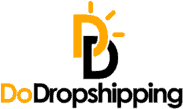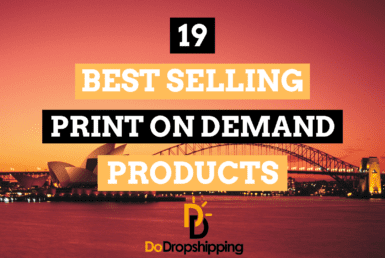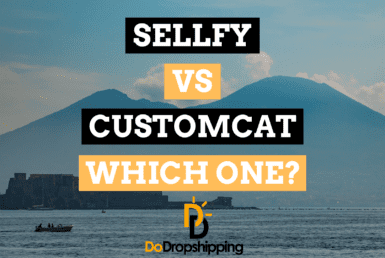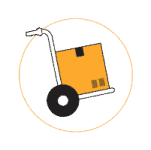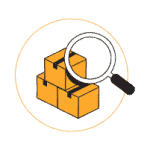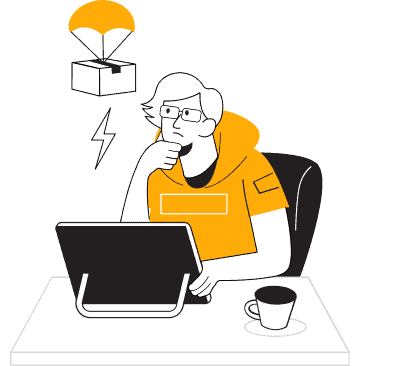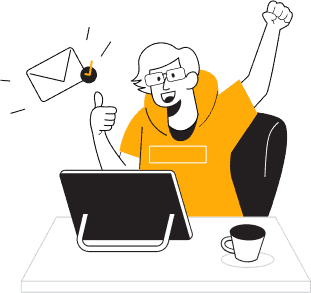You may have heard about dropshipping, but have you heard about Print on Demand (POD)?
If not, let's dive into everything you need to know, from how it works to the pitfalls to overcome and to answer if it's the right fulfillment model for your dropship business.
What is print on demand (POD)?
Let's start with this, what is print on demand?
Print on Demand (POD) is the fulfillment model that allows sellers to design graphics for products. These products are often apparel such as shirts and hoodies and can range from mugs, towels, art prints, phone cases, and more.
Without needing to hold on to the product like a physical retailer, the supplier will ship the product with your graphics on it for you!
This means you don't have to spend time and energy dealing with the process of the delivery and presentation of the product.
Here's an example of what the process will look like:
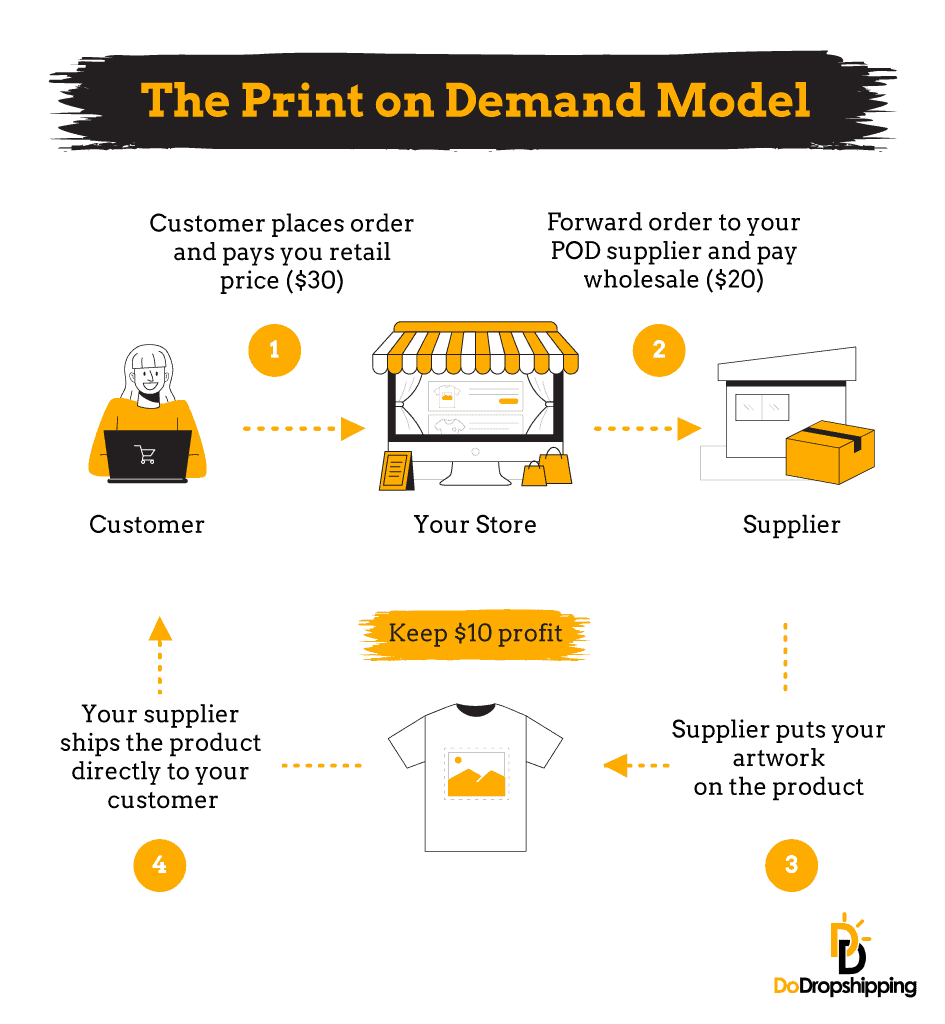
Looks awesome, right?
Is print on demand worth checking out?
If you’re an artist or graphic designer and want another source of revenue, then it's definitely worth checking it out. Whatever you are, POD is a simple, low-risk, cost-effective way of earning money as a full-time job or a side hustle.
This means you don't have to be a creative person to succeed (although it helps!) If you know someone or hire a designer, you can still reap all the benefits of owning a POD store.
If you're interested in learning more about if print on demand is worth it or not, check out our other article to see if print on demand is still profitable.
There might be confusion on what POD and other dropshipping models do, so let's clarify that now:
What is the difference between POD and normal dropshipping?
A business that offers print on demand services for their products will despatch the finished items directly to the customer when ordered. If that sounds like dropshipping, then you're right! Print on demand is another form of dropshipping.
Just take a look at this infographic here to see how ‘normal' dropshipping works:
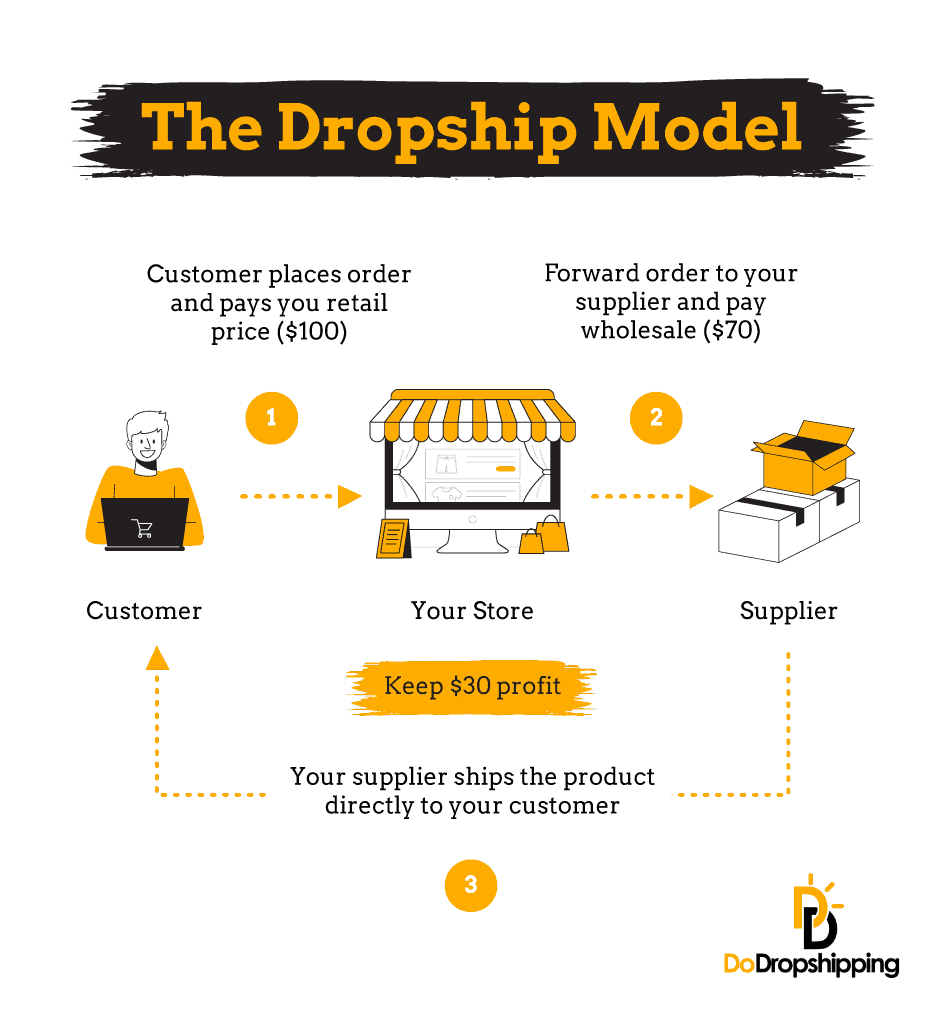
The differences are POD allows you to have more control over how the product looks, while traditional dropshipping is selling a premade product with very little to no customizability.
Fun fact: Did you know that you can also combine POD and ‘normal' dropshipping? Check out this article here!
If you're still a little confused or would like to see examples of the difference through successful stores, check out the article I linked to below:
Dropshipping vs. Print On Demand: What Is the Difference?
The pros and cons of print on demand
Now you know what print on demand is and how it differs from ‘normal' dropshipping, let's look at what's strengths and challenging areas you're going to overcome.
What print on demand is great in
Easy to set up. You can choose a supplier to upload your design to a product and then sell it on a website in a short amount of time. (More about that below)
Inexpensive. The upkeep costs of your business are largely just the website. This means the hosting, domain name, and a possible subscription to the website business depending on who you're using, like Shopify. There can be additional services and how you spend on marketing that can be additional costs.
No need to invest in inventory. Instead of investing thousands into products and then holding the inventory, you only need to pay once you make a sale. Since your product will cost more, you'll never pay more than you'll receive.
Having control of products. While there's only so much you can control a product (more on that later), you have control of the look via graphics.
This is a big deal when it comes to branding and competing with others. The design allows an advantage and gives a strong reason why someone should use it.
What print on demand struggles with
Low-profit margins. To make up the ease of not needing to worry about inventory, shipping, and product manufacturing, the supplier has to take a rather large cut. While suppliers can vary in pricing, profit margins tend to be a lot lower than dealing with shipping and inventory yourself.
Dealing with returns. It's quite the hassle to resell a purchased product due to its potential specifics and even custom-made. There are ways to repurpose it, though, so you may need to get creative to make the best of it. (More info here)
Only as good as your designs. The biggest reason anyone wants to purchase from your store is the quality and creative idea of the designs.
That means you need to put all your effort into making sure it has a demand. Low quality or quantity over quality can suffer greatly from getting sales, so it's best to invest as much as you can in high-quality designs.
No control of printing quality. Not every POD business can deliver a high-quality printed product with every order. Printers can mess up, and the people operating the printing can mess up as well.
Most importantly, the quality of the products they're using to be printed can below. This is why you should test them out for your own usage to determine how well they will work with your customers.
How do you get started with print on demand?
If, after reading the pros and cons, you're interested in starting with print on demand as well, then follow me along below to get started in five steps!
Note: If you want a more in-depth guide on starting a print on demand business, check out our other guide here!
1. Choose a supplier
Choosing a supplier can be a daunting task because there's a lot out there. Many of them specialize in offering a certain apparel brand or have competitive pricing and shipping times to make things easier.
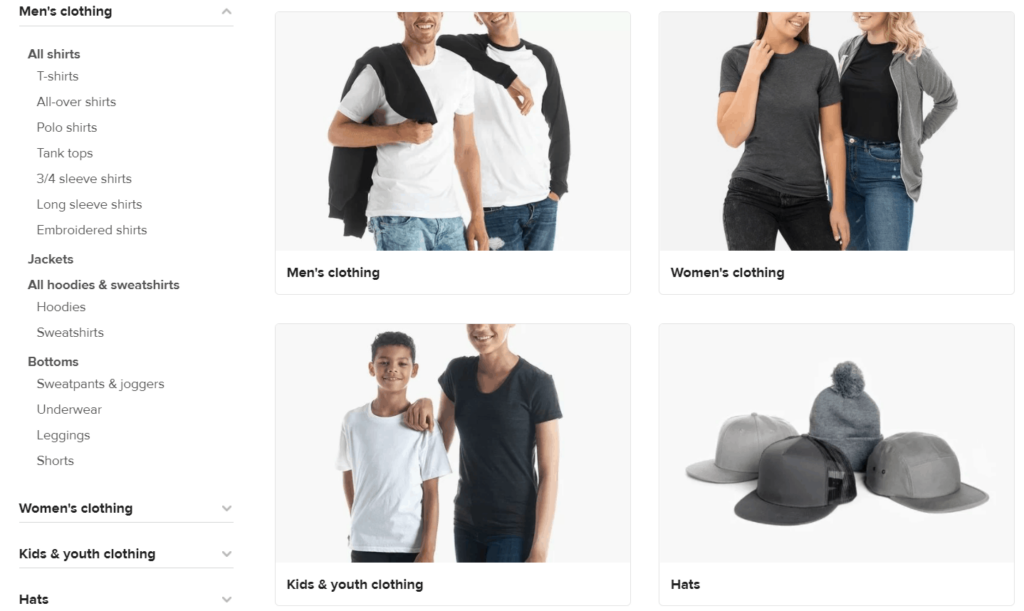
There is no one-size-fits-all for every POD business, so that's why it's hard to recommend one. The best one for you would be asking yourself questions like:
- Am I going to sell one kind of product?
- How many variants of my products am I using? (like size or product color, etc.)
- Is the pricing for the products and shipping fit in my budget to be profitable?
- What country/countries are you going to target?
Lastly, don't blindly accept a supplier without testing out the products yourself!
It's a great way to know the shipping times and print quality to know it's worth the price and be confident you're selling something worth buying.
If you're second-guessing between two of the most popular print on demand companies, Printful and Printify, then check out our in-depth comparison here.
Plus, you should check out these articles here to find the best print on demand supplier for your store:
- 14 Best US Print on Demand Suppliers in 2023 (Fast Shipping)
- 15 Best Print on Demand Companies and Suppliers in 2023
2. Upload your designs to the supplier's website
Once you have your supplier, their website is how their system will know what design and product you'll be selling on your website.

Once you have your design from a designer or yourself, you can now upload that design via their website. With their mock up generators they can show if the size of the design will fit nicely on the product.
Once it looks great, you can repeat every variant of a product you would like or more products with that design. Bear in mind, though, the resolution of the design may need to be increased depending on the size.
For example, a 200DPI can work on an 8×10″ art print, but it'll be way too low for a 24×36″ art print.
And yes, you can sell products in a specific niche!
Tip: Not sure which print on demand niche to sell in? Check out this article with 27 great POD niche ideas!
3. Create the product page with its information on your website
From the previous step, you can create a product page on your website where your customer can buy the product with your graphic on it.
Don't worry about the product images and description; your supplier has tools on their website to make and set up your website.
To go the extra mile with images and product descriptions
Use mockups images to create different angles of your products, especially worn or used by a real-life model. This will add a sense of realism.
Write a product description that uses the five senses of taste, touch, smell, hear, and sight. Even if not all those senses used by your product, give your customer a sense of feeling like it matters.
Use nostalgia and other emotions people can associate with your graphics.
For more information, check out our other article here with 10 product page examples that you can learn a lot from!
4. Sync the graphic and product with the supplier's website to your website
Once the product page is set on your website, it's now time to go to the sync page of your supplier to make sure the product and the graphic are matching your website.

On there, you can select your product, its variants of colors and/or sizes, and your design to be placed on it. It's super simple, and with a press of a button, anyone who purchases from your website will automatically be ordered from your supplier.
This includes address information and name, so you don't have to worry about anything about the customer receiving it. (Unless they make a mistake but more info on how we can make the best of it later on in the article)
5. Market your products

This is the hardest part for a lot of people because of the skillset and creativity on how you want your store to be seen and purchased from.
While there are many strategies on platforms that work well, such as Google Ads and Facebook Ads, there are also marketplace websites you can sell on such as:
What you need to know about selling POD products is you're essentially selling art. This means it's not the usual ‘find a problem and sell it as a solution'. Art is seen as an emotional sense of expression and feeling of belonging to something.
This is why a lot of POD apparel has big causes like supporting culture or nonprofit activism. Also, celebrities, rock bands, and brands selling other kinds of products can all benefit from POD products that make their fans want to show off their loyalty.
The sky's the limit in the marketing direction. That's why we made other helpful guides that cover that here, so you can check them out once you're done with this article.
And don't forget to check out our full guide on how to start a print on demand business here!
15 Print on demand store examples
Now that you know how to get started, let's see what other stores are doing with their print on demand business that makes them successful.

We rounded up 15 Print on demand store examples and showcasing what each one does right so you can learn and apply them to your store as well!
Print on Demand: FAQ beginner questions
Before we close off this article, let’s quickly go over a few key questions that people have when they start with their print on demand store.
Who knows, maybe this will answer one of the questions you had as well!
How do you get inspiration for the designs?
Because your designs' quality and creative ideas are what matters the most, it makes sense to gather the best inspiration in preparation.
So, where do you look for inspiration? The easiest and simplest way is to use google to search through related art. This can be as simple as ‘elephant graphics.'
Another example is Dribbble!

There are tons of similar art and styles out there. It's just about being curious and searching around.
It is worth noting the most obvious is to gain inspiration from your competitors to see what's selling and what isn't. Although there is nothing wrong with this necessarily, it can be too inspiring or infringing copyright.
Copyright infringement is the protection that the design cannot use without the owner's permission. This helps you from getting your design used by competition for their gain. (More information about that here)
A great way to gain inspiration for new designs is to combine ideas that will create something new. Another way is to purposely use challenges like only using one single line or one shade of color to get your creative muscles an exercise!
How do you deal with print on demand product returns?
This probably the biggest problem you'll face that all dropshippers deal with. At the same time, the first thought would be just to hold on to the product and wait for someone else to purchase it and then ship it to them.
That might not happen, though. The product could be a custom-made design of someone's child that no one would else buy. This means you're stuck with a product taking up space and may have lost money due to shipping.
All is not lost! Just because you cannot sell it does not mean the product should instantly be thrown away. There are other creative ways to repurpose the returned product.
For example, someone can wear a shirt for lifelike modeling photos. These are often better than the standard mock-up photos because they're shown in a real-world setting. It also makes it easier for your visitor to imagine themselves wearing it too!
Depending on the product, you can also host a giveaway so your participates can enter by doing something like following your business on Instagram. These are just some of the many ideas you can use for your returned products to enhance your business further instead of hindering it.
Interested in learning more about dealing with print on demand returns? Check out our in-depth guide here!
So, should you use print on demand?
Print on demand is a very straightforward fulfillment method, so this means a lot of people can try it out with little risk. But is this something for you to dive in with full effort, though?
The answer is that it comes down to your own creativity or ability to have access to someone. Then rest is largely marketing you to success with your designs.
You also have more control over the products than the regular dropshipping from AliExpress since your designs will be original that can't be replicated by the competition.
This means it's easier to build a brand for people to believe in that can go beyond selling products. As shown from the 15 POD store examples, each one successfully supports a great cause or a social statement that makes people feel like they belong.
If you're a creative artist, then the answer comes down to how much time and effort you are willing to put into it? Although it's quite fast to get a business running, it'll always be a side hustle unless you treat it like a business.
When in doubt, put all your effort into the designs. This makes marketing them a lot easier because there's less effort to get people to believe in a mediocre design when a great can sell itself.
Conclusion
POD dropshipping is a powerful and useful way to add another revenue to your business or be a business within itself. The limitations are literally your own creativity in presenting your business and the designs you wish to use with it.
While the model will encounter some bumps in the process, they are all manageable. Also, with the inexpensive start-up costs, there's very little reason not to try it out.
So what are you waiting for? Your next move awaits you!
Want to learn more about POD?
Ready to move your print on demand store to the next level? Check out the articles below:
